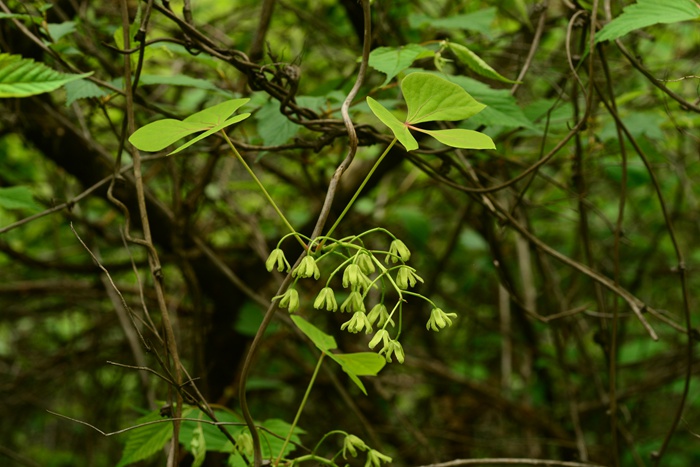- Scientific Name: Sargentodoxa cuneata (Oliv.) Rehder & E.H.Wilson
- Ref: C.S.Sargent, Pl. Wilson. 1:353. 1913
- Synonyms: Holboellia cuneata Oliv.; Sargentodoxa simplicifolia S.Z.Qu & C.L.Min
- Chinese Common Name: 大血藤 dà∙xiěténg
- Family: Lardizabalaceae
- Genus: Sargentodoxa
- Distribution: Open forests on mountain slopes or in gullies; 400–1600(–2000) m. Anhui, Fujian, Guangdong, Guangxi, Guizhou, Hainan, Henan, Hubei, Hunan, Jiangsu, Jiangxi, S Shaanxi, Sichuan, SE Yunnan, Zhejiang [Laos, N Vietnam].
- Photo: 05/06/2017, Qingliang Peak, Zhejiang
Bark with longitudinal fissures. Stems with red sap, cross section with radiated markings; branches red-brown to brown, subterete. Winter buds with many imbricate scales; scales scarious, outer ones ovate, inner ones oblong-ovate. Leaves (1 or)3-foliolate; petiole 5--10 cm, slender, channeled; leaflets unequal; lateral leaflets subsessile, subdeltoid, extremely asymmetric with inner basal angle narrowly cuneate and outer basal angle truncate to oblique ovate, usually slightly larger than terminal one; terminal leaflet petiolules 5--10 mm; blade rhomboid-ovate, 4--14 × 3--cm, base cuneate, apex acute. Inflorescences solitary, many-flowered, loose racemes, pendulous, 8--15 cm. Flowers fragrant, yellow to yellowish green. Pedicels 1--1.5 cm, with 1 oblong bract at base; bracteoles 2, at middle of pedicel, alternate, awl-shaped. Male flowers: sepals imbricate in bud, ± erect to spreading, narrowly oblong, 6--10 × 2--4 mm, margin slightly revolute. Petals rhomboid-orbicular, ca. 1.2 mm. Sta-mens ca. 4 mm; filaments 1--1.5 mm; anthers oblong. Female flowers: receptacle subglobose to oblong, ca. 1.4 × 1.2 cm. Fruit 20--40, dull blue, berrylike, stipitate, 7--10 mm in diam. Seeds blackish, ovoid, ca. 5 mm. Fl. Mar--Jul, fr. Jun--Oct. (Flora of China)
